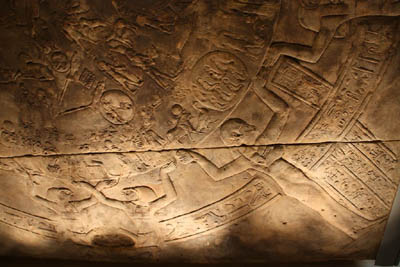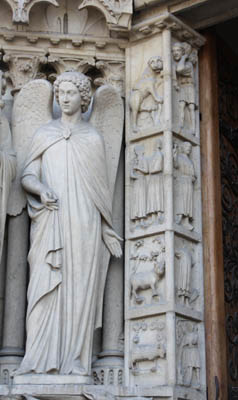Un jour, Une Œuvre,
04/04
Zodiac of Dendera
D 38
Hall 12 bis
In Egyptian mythology,
Nout is the goddess
personifying the sky. AE9
It is commonly represented in the guise of a woman’s body elongated above the earth.
It sometimes takes the appearance of a gigantic cow. On his belly are attached the stars.
Note here the women wearing the sky.
This view contrasts sharply with the simple imaginary but the Bible accurately states:
"He is stretching out the north over the empty place, hanging the earth upon nothing."
- Job 26:7.
Astrology, Zodiac in Egypt and Babylon
Astrology had a big place
in the art of divination from
the second millennium BC
when the Babylonian priests established the zodiac.
This term comes from a Greek word that means circle
of animals. AE10 The signs do not correspond
to the constellations, which earned them their original name. The cult of the stars
was particularly dominant
in Babylon. 
Details of a woman wearing the sky.
The servants of God took a strong stand against the cult of the stars. They shared the view of the Scriptures, seeing them as mere material bodies that do not dominate man but rather serve as lighting and benchmarks. The faithful King Joshua "put out of business the foreign-god priests [...], those making sacrificial smoke to Ba´al, to the sun and to the moon and to the constellations of the zodiac." (2 Kings 23:5). This expression comes from the Hebrew word mazzalôth, plural, which appears only once in the Bible.
It should be noted that the signs of the zodiac were introduced in the cathedrals of Christendom, and in Paris can be seen on the portal and left around Mary in the huge central rose of Notre-Dame de Paris and Burgundy the facade of the Basilica of Vezelay. Historians of art have long recognized the influence. AE11 , AE12
signs of the zodiac on cathedral Notre-Dame de Paris
Portal of the Virgin, Facade of Notre-Dame, Paris
On the lower sides of this portal of small bas-reliefs depicting themes of the month and the corresponding signs of the zodiac.
Classical Antiquity imagined the universe as an interlocking sphere:
the stars had fixed positions and were un moveable.
Islam took these designs.
This is not the case of biblical writings. AE13,
AE14 "He is stretching out the north
over the empty place,
hanging the earth upon nothing"
Job 26:7
Around 1500 BC
In VIII th century BC,
Isaiah spoke of the "circle of the earth" (Isaiah 40:22).
The Hebrew word hhug can also mean 'sphere'.
In the Bible of Glaire ,
the text reads: "He who dwells on the globe of the earth."
Long before Aristotle (384-322 BC),
who believed that the stars were planted in the sky as nails,
Genesis (1:6-8) spoke of the sky as an extended (NWT, Thompson).

NASA Goddard Space Flight Center
Image by Reto Stöckli
Jerome used the term firmament (Osty) in the Latin Vulgate, and whose meaning is that of 'solid vault' (see also The New American Bible, Revised Edition, 2011 ”He sits enthroned above the vault of the earth “) The Hebrew term used by Moses raqia evokes the idea of extension or even better expansion.
.JPG)



